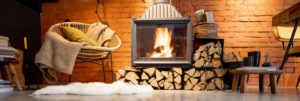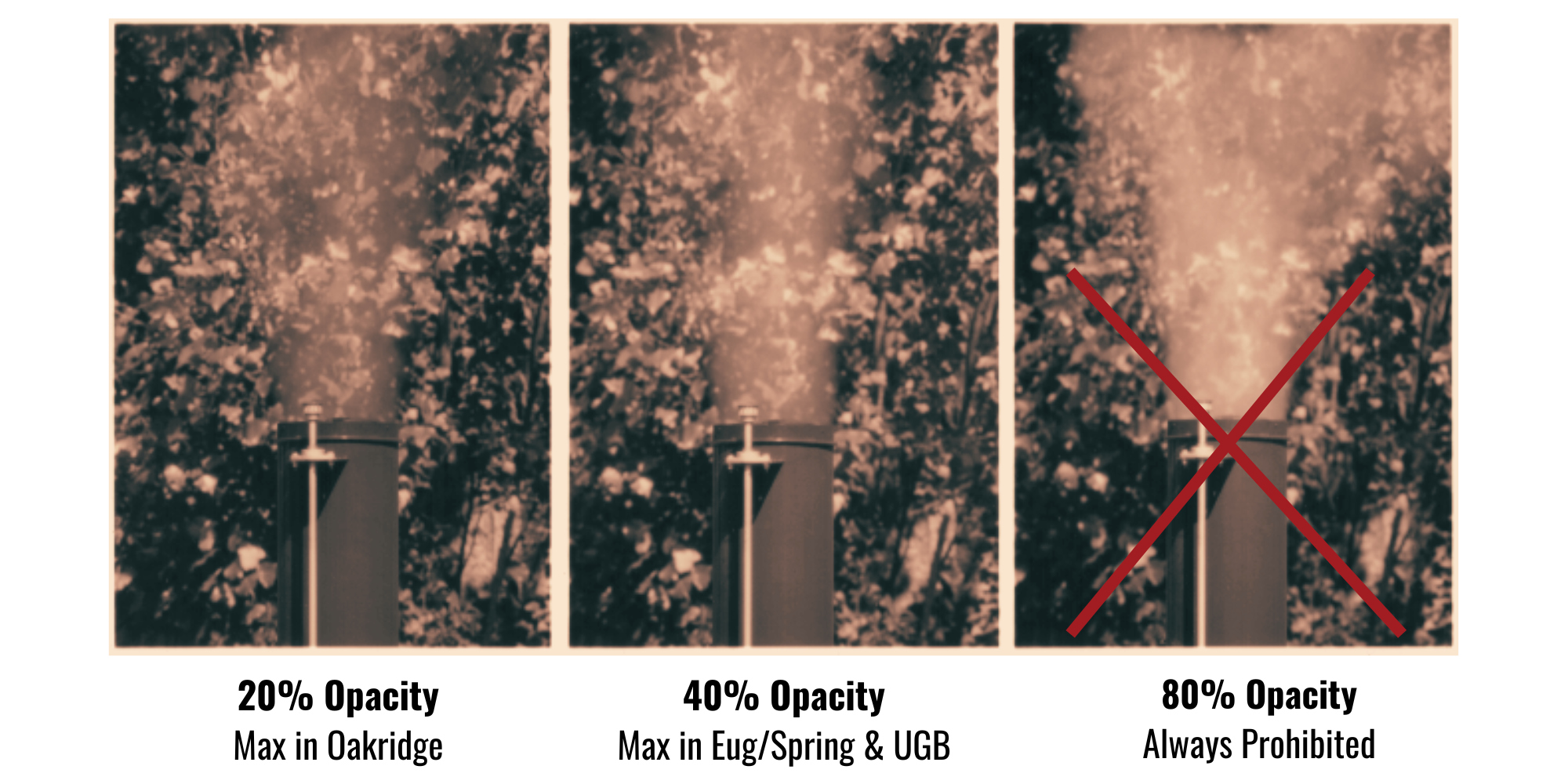Home Wood Heating
Generating excess or unnecessary chimney smoke is not only un-neighborly, it’s against the law in parts of Lane County. More importantly, it’s a clear sign you’re not getting the most out of your fuel to heat your home. By minimizing smoke from your chimney you increase the heat you get from your wood, and limit your impact on your neighbors.
Residents of Lane County are allowed to operate home wood heating devices at any time during the year. Those who live within the city limits or urban growth boundary of Eugene, Springfield, or Oakridge, are subject to opacity limits for the smoke produced by these devices (see “Smoke Opacity” below for more information). LRAPA promotes efficient burning practices to help people emit less air pollution while using wood stoves and fireplaces. The following tips can help maximize efficient wood burning practices: check and follow the daily home wood heating advisory on this webpage, only burn seasoned wood, build small, hot fires, check dampers for sufficient airflow, and annually clean and maintain the chimney.
During periods of cold weather, fireplace and wood stove usage increases dramatically in Lane County. This increases the amount of wood smoke pollution, called particulate matter, emitted into our shared air. Within the city limits or urban growth boundary of Eugene, Springfield, and Oakridge, a daily home wood heating advisory is posted on LRAPA’s website from October 1 through May 31 (see “Daily Advisory” on this webpage). Those located in these areas should review the daily advisory and comply with the advisory requirements.
Please Burn Responsibly
- Sign up for burn ban and air quality alerts
- Never burn garbage – it’s against the law.
- If you’re not sure how to properly and safely operate your wood stove or fireplace, consult a wood stove dealer.
Home Wood Heating Advisory Line: (541) 746-4328
The Home Wood Heating advisory is issued at 2:00 p.m., goes into effect at 4:00 p.m., and continues through 4:00 p.m. of the following day.
For the full Home Wood Heating Curtailment Program Enforcement Rules, see LRAPA Title 16 which also refers to specific local city ordinances and the state’s Heat Smart rules.
Sign up for Updates!

Home Wood Heating Season
During periods of cold weather, fireplace and wood stove usage increases dramatically in Lane County. This increases the amount of wood smoke pollution — called Particulate Matter — into our shared air. Health studies have shown a significant association between exposure to Particulate Matter and health risks, including premature death. Short-term health effects may include cardiovascular effects such as cardiac arrhythmias and heart attacks, and respiratory effects such as asthma attacks and bronchitis. Long-term health effect may include lung cancer and other forms of heart and lung disease.
During home wood heating season, LRAPA issues a daily color coded home wood heating advisory at 2:00 p.m. which begins at 4:00 p.m. and lasts for 24 hours.
- GREEN advisories indicate air quality is clear enough to use a woodstove or fireplace. However, there is a limit to how much visible smoke can be produced. It is illegal for thick smoke to come from a chimney stack. Smoke should be barely visible and as light as possible. In the city of Eugene and Springfield and their Urban Growth Boundaries (UGB), smoke cannot exceed 40% opacity. In the city of Oakridge and its Urban Growth Boundary (UGB), smoke cannot exceed 20% opacity. See opacity descriptions in next column.
- YELLOW advisories are cautionary warnings about air quality. Issued during periods of air stagnation when smoke may not ventilate well. While it is legal to use your woodstove or fireplace, LRAPA strongly encourage people to use other forms of heat when possible like electric, propane, or natural gas. 40% opacity limits still apply in Eugene and Springfield and UGB, and 20% opacity limits still apply in Oakridge and UGB.
- RED advisories prohibit visible emissions from all wood stoves, pellet stoves, and fireplaces within the city limits of Eugene, Springfield and Oakridge and their UGBs. Only those with an approved economic exemption letter (from LRAPA within the city limits Eugene/Springfield, or from Oakridge within the city limits of Oakridge) may have a maximum of 20% opacity for smoke in Oakridge and maximum of 40% opacity in Eugene and Springfield and UGB, otherwise any use of a woodstove must have zero visible emissions and only if absolutely necessary for heating.

Opacity is defined as the percentage of the background that is obscured (blocked) by visible emissions/smoke, i.e., the smoke’s ability to obscure the background. The thicker the smoke, a higher opacity value in the visible emission/smoke means there is more particulate matter leaving the chimney and entering the air, which results in less of the background being visible.
All wood stove and chimney users must ensure the opacity levels of the smoke from their chimney or stack remain transparent and easy to see through. Using clean and dry wood to create a small and hot fire with open dampers should result in barely visible smoke at the outlet of a chimney or stack.
Within the city limits and urban growth boundary of Eugene and Springfield, the opacity limit is 40%.
Within the city limits and urban growth boundary of Oakridge, the opacity limit is 20%.

100% opacity means the smoke plume is a solid color, and one is unable to see through the plume. At 10% opacity, smoke emissions are barely detectable. At 20% opacity, a faint smoke plume is identifiable. At 40% opacity, a smoke plume is easily identifiable but transparent enough to see a contrasting background through the plume. Opacity levels below 20% generally indicate efficient combustion. At or above 20% opacity indicates inefficient combustion.
